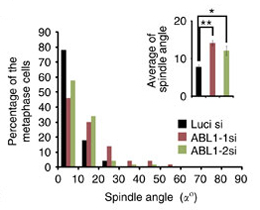Research Abstract
ABL1は付着細胞と哺乳類皮膚における紡錘体の配向を調節する
ABL1 regulates spindle orientation in adherent cells and mammalian skin
2012年1月17日 Nature Communications 3 : 626 doi: 10.1038/ncomms1634

哺乳類において、適切に制御された紡錘体の配向を示す証拠は増えつつあるが、哺乳類細胞で紡錘体の配向を制御する遺伝子を同定する系統的な手法はまだ確立されていなかった。我々は、HeLa細胞を用いて全てのキナーゼを標的としたRNAiスクリーニングを行い、ABL1が紡錘体配向の新規制御因子であることを突き止めた。ABL1をノックダウンすると、進化の過程で保存されてきた紡錘体配向制御因子であるLGN(Lue-Gly-Asn repeat-enriched protein)の細胞表層への蓄積が引き起こされ、その結果LGNに依存した紡錘体の回転と紡錘体の配向の異常が起こる。in vivoで阻害薬物あるいはabl1遺伝子のノックアウトによってABL1を不活性化すると、マウス皮膚での紡錘体配向の異常とLGNの局在化の異常が起こる。また、ABL1はLGNに結合するタンパク質であるNuMAの1774番目のチロシンを直接リン酸化する。このリン酸化によってNuMAは分裂期中期を通して表層に局在するようになり、LGN/NuMAに依存した紡錘体配置の制御が確実に行われるようになる。この研究は、哺乳類細胞における紡錘体の配向を制御する遺伝子を同定する新規な手法を示すとともに、この機序にかかわるこれまで知られていなかったシグナル伝達経路を明らかにしている。
- 京都大学ウイルス研究所 細胞生物学研究部門
- 京都大学 大学院生命科学研究科 高次生体機能学
- 京都大学 iPS細胞研究所CiRA 初期化機構研究部門
- 京都大学 物質-細胞統合システム拠点
- 科学技術振興機構(JST)戦略的創造研究推進事業(CREST)
- 京都大学生命科学系キャリアパス形成ユニット
- 奈良先端科学技術大学院大学 バイオサイエンス研究科
- 京都大学 大学院生命科学研究科 多細胞体構築学
Despite the growing evidence for the regulated spindle orientation in mammals, a systematic approach for identifying the responsible genes in mammalian cells has not been established. Here we perform a kinase-targeting RNAi screen in HeLa cells and identify ABL1 as a novel regulator of spindle orientation. Knockdown of ABL1 causes the cortical accumulation of Leu-Gly-Asn repeat-enriched-protein (LGN), an evolutionarily conserved regulator of spindle orientation. This results in the LGN-dependent spindle rotation and spindle misorientation. In vivo inactivation of ABL1 by a pharmacological inhibitor or by ablation of the abl1 gene causes spindle misorientation and LGN mislocalization in mouse epidermis. Furthermore, ABL1 directly phosphorylates NuMA, a binding partner of LGN, on tyrosine 1774. This phosphorylation maintains the cortical localization of NuMA during metaphase, and ensures the LGN/NuMA-dependent spindle orientation control. This study provides a novel approach to identify genes regulating spindle orientation in mammals and uncovers new signalling pathways for this mechanism.

